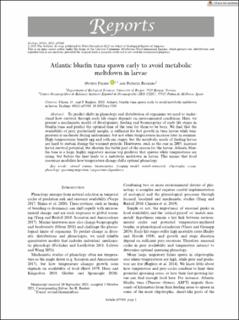| dc.contributor.author | Fiksen, Øyvind | |
| dc.contributor.author | Reglero, Patricia | |
| dc.date.accessioned | 2022-04-07T08:45:38Z | |
| dc.date.available | 2022-04-07T08:45:38Z | |
| dc.date.created | 2021-11-25T19:33:23Z | |
| dc.date.issued | 2022 | |
| dc.identifier.issn | 0012-9658 | |
| dc.identifier.uri | https://hdl.handle.net/11250/2990420 | |
| dc.description.abstract | To predict shifts in phenology and distribution of organisms we need to understand how survival through early life stages depends on environmental conditions. Here, we present a mechanistic model of development, feeding and bioenergetics of early life stages in bluefin tuna and predict the optimal time of the year for them to be born. We find that the availability of prey, particularly nauplii, is sufficient for fast growth in tuna larvae while temperature is moderate during midsummer, but not when temperatures increase later in summer. High temperatures benefit egg and yolk-sac stages, but the metabolic needs of feeding larvae are hard to sustain during the warmest periods. Heatwaves, such as the one in 2003, increase larval survival potential, but shorten the viable part of the season for the larvae. Atlantic bluefin tuna is a large, highly migratory marine top predator that spawns while temperatures are rising, but before the heat leads to a metabolic meltdown in larvae. This means that food resources modulate how temperature change shifts optimal phenology. | en_US |
| dc.language.iso | eng | en_US |
| dc.publisher | Wiley | en_US |
| dc.rights | Navngivelse-Ikkekommersiell 4.0 Internasjonal | * |
| dc.rights.uri | http://creativecommons.org/licenses/by-nc/4.0/deed.no | * |
| dc.title | Atlantic bluefin tuna spawn early to avoid metabolic meltdown in larvae | en_US |
| dc.type | Journal article | en_US |
| dc.type | Peer reviewed | en_US |
| dc.description.version | publishedVersion | en_US |
| dc.rights.holder | Copyright 2021 The Author(s) | en_US |
| dc.source.articlenumber | e03568 | en_US |
| cristin.ispublished | true | |
| cristin.fulltext | original | |
| cristin.qualitycode | 2 | |
| dc.identifier.doi | 10.1002/ecy.3568 | |
| dc.identifier.cristin | 1959377 | |
| dc.source.journal | Ecology | en_US |
| dc.identifier.citation | Ecology. 2022, 103(1), e03568. | en_US |
| dc.source.volume | 103 | en_US |
| dc.source.issue | 1 | en_US |

